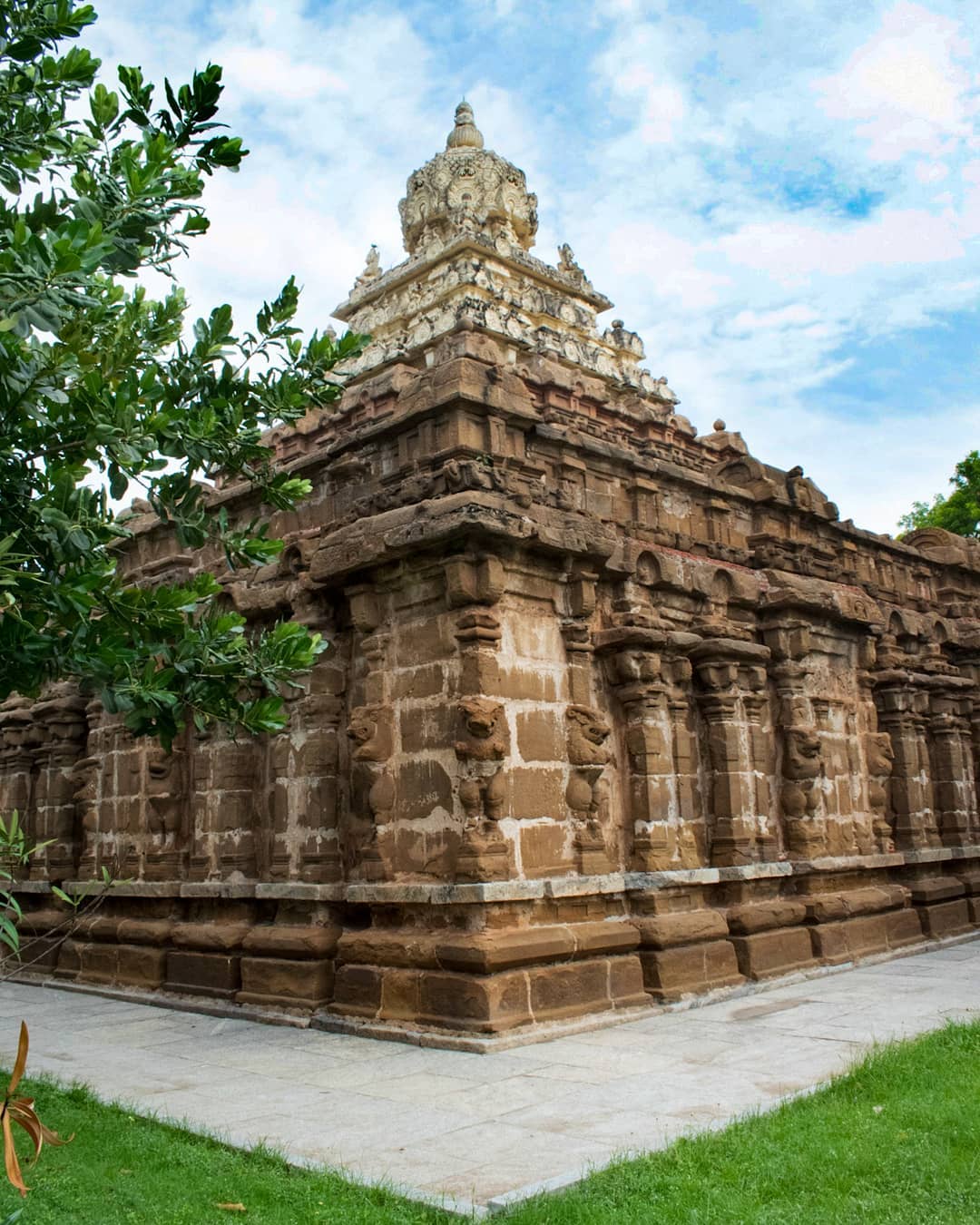Introduction
## The Pallava kings ruled around the prosperous agrarian settlement and important trade centre of Kanchipuram on the southeast coast of India.
##Kanchipuram was well known to Chinese and Roman merchants.
##.From the flourishing trade centre of Kanchipuram, the later Pallavas extended their sovereignty over all the Tamil-speaking regions during the 7th and 8th centuries.
##.The central part of their kingdom, however, was Thondaimandalam, a large political region comprising northern parts of Tamil Nadu and the adjoining Andhra districts.

Sources
Inscriptions -Mandagapattu Cave, Aihole Inscription of Pulakesin II
Copper Plates
Kasakudi Plates
Literature
Mattavilasa Prahasana, Avanthi Sundarakatha, Kalingathu Parani, Periya Puranam, Nandi Kalambagam
Foreign Notice
Accounts of Chinese traveller Hiuen Tsang
Pallava Genealogy (Prominent Kings)
##.There were early Pallava rulers who were feudatories of Satavahanas.
##.Simhavishnu, son of Simhavarman II (around 550 AD (CE), created a strong Pallava kingdom after destroying the Kalabhras.
##.He defeated many kings in the south including the Cholas and the Pandyas.
##.His able son was Mahendravarman I. He was succeeded by his son Narasimhavarman I.
##.The other prominent Pallava rulers were Narasimhavarman II or Rajasimha and Nandivarman II.
##.The last Pallava ruler was Aparajita. Mahendravarman (c.600–630AD (CE)) contributed to the greatness of the Pallava kingdom.
##.Mahendravarman I was a follower of Jainism in the early part of his rule.
##.He embraced Saivism by the Saivite saint Appar (Tirunavukkarasar).
##.He was a great patron of art and architecture. He is known for introducing a new style to Dravidian architecture, which is referred to as ‘Mahendra style’.
##.Mahendravarman also wrote plays, including (c.620) MattavilasaPrahasana. (The Delight of the Drunkards) in Sanskrit, which denigrates Buddhism.
##.Mahendravarman’s reign involved constant battles with the Western Chalukya kingdom of Badami under Pulakesin II.
Pulakesin seems to have defeated ##.Mahendravarman in one of the battles and taken over a large part of his territory (Vengi) in the north.
##.His son Narasimavarma I (c. 630–668) avenged the defeat by capturing Vatapi, the capital of Chalukyas.
##.He set Vatapi on fire, killing Pulakesin in the process .
##.Narasimhavarman II (c. 695–722), also known as Rajasimha, was a great military strategist.
##.He exchanged ambassadors with China. His reign was comparatively free from any political disturbance.
##.Therefore, he could concentrate on temple-building activities.
##.During his reign, the famous Kailasanatha temple at Kanchipuram was built.
Name of the King and Title/s Adopted
1.Simhavishnu
Avanisimha
2.Mahendravarma I
1. Sankirnajati
2.Mattavilasa
3.Gunabhara
4.Chitrakarapuli
5.Vichitra Chitta
3. Narasimhavarma I
1. Mamallan
2.Vatapi Kondan
Pallava’s Contribution to Architecture
##.Pallava period is known for architectural splendour.
##.The Shore Temple and various other temples carved from granite monoliths and the Varaha cave (7th century) at Mamallapuram, are illustrious examples of Pallava architecture.
##.In 1984, Mamallapuram was added to the list of UNESCO World Heritage Sites .
Pallava architecture can be classified as
1. Rock-Cut temples – Mahendravarman style 2. Monolithic Rathas and Sculptural Mandapas – Mamallan style
3. Structural Temples – Rajasimhan style and Nandivarman style
Mahendra Style
##.The best example of MahendraVarma style monuments are cave temples at Mandagapattu, Mahendravadi, Mamandur, Dalavanur, Tiruchirapalli, Vallam, Tirukazhukkundram and Siyamangalam.

Fig – Mandagapattu Cave Temple
Mamalla Style
##.The five rathas (chariots), popularly called Panchapandavar rathas, signify five different style of temple architecture.

Fig – Five Rathas
##.Each ratha has been carved out of a single rock. So they are called monolithic.
##.The popular mandapams (pillared pavilions) they built are Mahishasuramardhini mandapam, Thirumoorthi mandapam and Varaha mandapam.
##.The most important among the Mamalla style of architecture is the open art gallery.
##.Several miniature sculptures such as the figure of lice-picking monkey, elephants of huge size and the figure of the ascetic cat have been sculpted beautifully on the wall of a huge rock.

Fig : Open Art Gallery
##. The fall of the River Ganga from the head of Lord Siva and the Arjuna’s penance are notable among them.
##.The Great Penance panel is considered to be the world’s largest open-air bas relief.
Rajasimha Style
##.Narasimhavarma II, also known as Rajasimha, constructed structural temples using stone blocks.
##.The best example for the structural temple is Kailasanatha temple at Kanchipuram.
##.This temple was built by using sand stones. Kailasanatha temple is called Rajasimheswaram.

Nandivarma Style
##.The last stage of the Pallava architecture is also represented by structural temples built by the later Pallavas.
##.The best example is Vaikunda Perumal temple at Kanchipuram.

Society and Culture
##.The Pallavas supported Jainism, Buddhism and the Vedic faith.
##.They were great patrons of music, painting and literature.
##.Some of the Pallava kings patronised the Azhwars and Nayanmars.
##.These exponents of Bhakti Cult preached a new form of Vaishnavism and Saivism.
Among the Saivites were Appar and Manikkavasakar.
##.Among the Vaishnavites were Nammazhvar and Andal.
##.The Bhakti movement aimed at preaching a popular faith, in which prayers in Tamil were preferred to those in Sanskrit.
##.Women were encouraged to participate in the religious congregations.
##.The Tamil devotional cult was competitive with Buddhism and Jainism.
##.Therefore the latter suffered a gradual decline in most parts of Tamil country.
Education and Literature
##.Gatika (monastery or centre of learning) at Kanchi was popular during the Pallava
times and it attracted students from all parts of India and abroad.
##.Vatsyaya who wrote Nyaya Bhashya was a teacher at Kanchi (Gatika).
##.The treatise on Dakshin Chitram (Paintings of South India) was compiled during the reign of Mahendravarma I.
##.The great Sanskrit scholar, Dandin, adorned in the court of Narasimhavarma I.
##.Dandin composed Dashakumara Charita. Bharavi, the great Sanskrit scholar, lived in the time of Simhavishnu.
##.Bharavi wrote Kiratarjuniya, an epic in verses. Tamil literature had also flourished during the Pallava rule.
##.Thevaram composed by Nayanmars and Nalayradivyaprabantham composed by Azhwars, which are still chanted by devout people.
##.Perundevanar, who was patronized by Nandivarman II, translated the Mahabharata into Tamil as Bharathavenba.
Pallava Art
##.The Pallava kings had also patronised fine arts.
##.The music inscriptions in Kudumianmalai and Thirumayam temples show Pallavas’ interest in music.
##.The famous musician Rudracharya lived during Mahendravarma I.
##.The sculptures of this period depict many images in dancing postures .
